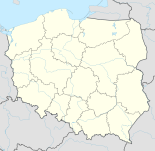Niedamirów
| Niedamirów | ||
|---|---|---|
 Help on coat of arms |
|
|
| Basic data | ||
| State : | Poland | |
| Voivodeship : | Lower Silesia | |
| Powiat : | Kamienna Góra | |
| Geographic location : | 50 ° 41 ′ N , 15 ° 53 ′ E | |
| Height : | 590-710 m npm | |
| Residents : | ||
| Telephone code : | (+48) 75 | |
| License plate : | DKA | |
| Economy and Transport | ||
| Street : | Lubawka - Opawa - Niedamirów | |
| Next international airport : | Wroclaw | |
Niedamirów (German Kunzendorf ) is a district of the rural community Lubawka ( Liebau ) in the powiat Kamiennogórski in the Lower Silesian Voivodeship in Poland.
geography
Niedamirów is located in the Rehorn Mountains , right on the border with the Czech Republic . It is reached via a strait from Jarkowice ( urban Hermsdorf ), which ends in Niedamirów. Neighboring towns are Opawa and Miszkowice in the north and Paprotki ( urban Hartau ) and Lubawka in the northeast. Across the border with the Czech Republic, which can be reached via the Lubawka– Královec car border crossing , are Královec in the east, Lampertice in the southeast, Bobr , Křenov ( Krinsdorf ) and Žacléř in the south, Dolni Lysečiny ( Ober Kolbendorf ) and Albeřice ( Albendorf ) in the West and Mala Úpa ( Kleinaupa ) in the northwest.
history
The area around Kunzendorf initially belonged to Bohemia and passed to Duke Bolko I in the 13th century . Kunzendorf was probably founded at the beginning of the 14th century and belonged to the Seidlitz family . Together with the Duchy of Schweidnitz , it came back to the Crown of Bohemia in 1368 . Until 1378 it was together with Oppau , Buchwald and Tschöpsdorf Witwengut of Marita von Se (i) dlitz, a court master of the Duchess Agnes . In that year, Marita's sons Hans Schonevogel and Kuncze Hunder Kunzendorf and the other named places with all their property and rights sold to the Cistercian monastery of Grüssau . To meet the Turkish tax , Kunzendorf had to be pledged together with Oppau, Tschöpsdorf and Buchwald in 1558. Lutheranism developed in the villages during the pledge period . After returning to the monastery, the population was recatholicized.
After the First Silesian War , Kunzendorf fell to Prussia in 1742, together with Silesia . In 1810 the monastery property was secularized . After the reorganization of Prussia in 1815, Kunzendorf belonged to the province of Silesia and from 1816 was incorporated into the Landeshut district, with which it remained connected until 1945. It formed its own rural community and has been part of the Oppau district since 1874 . In 1939 there were 456 residents in Kunzendorf.
As a result of the Second World War , Kunzendorf fell to Poland in 1945, like almost all of Silesia, and was renamed Niedamirów . The German population was expelled. Some of the new residents were displaced from eastern Poland . 1975-1998 Niedamirów belonged to the Jelenia Góra Voivodeship . Since 1995 there has been an annual "Festival of Three Cultures" ( Festiwale Trzech Kultur ) in Niedamirów , which aims to promote understanding between Germans, Czechs and Poles.
Personalities
- Christian Benjamin Klein (born May 14, 1754 in Kunzendorf; † September 17, 1825 in Schmiedeberg), organist and cantor
literature
- Ernst Kunick (Hrsg.): Home book of the district Landeshut. Grenzland-Druckerei Rock & Co., Wolfenbüttel 1954.
- Father Ambrosius Rose: Grüssau Monastery . Konrad Theiss Verlag , Stuttgart and Aalen 1974, ISBN 3-8062-0126-9 , pp. 35, 56 and 57.
Web links
Footnotes
- ^ Franz Mahner: Economic history of the Cistercian monastery Grüssau , in: History of the Pielenhofen Monastery , based on sources. by Anton Eder, Verlag by Alfred Coppenrath, Regensburg 1865, p. 82.
